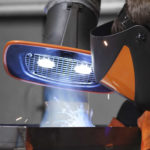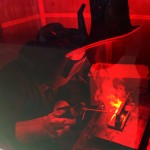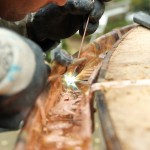Manual arc welding: Chromium VI compounds and more besides in the welding fumes
Up to the formation of chromium VI compounds: In manual arc welding, the kind of hazardous substances in the welding fumes is very much determined by the metal of the core rod and its covering. Particularly hazardous are high-alloy rod electrodes.
On account of its versatility, manual arc welding – also referred to as manual electrode welding – is often employed, for instance, in building and steel construction, piping and also outdoors. After all, it ranks amongst the oldest electric welding procedures for metal materials. However, manual arc welding poses a risk to health. Toxic welding fumes develop – and, in particular, high-alloy core rods pose a substantial health risk.
The materials being processed determine which hazardous substances arise
Welders mainly deploy manual arc welding in steel construction and piping. After all, the equipment outlay here is relatively low compared to other procedures. An electric arc between an electrode melting as a filler metal and the work piece is used as heat for welding. The high arc temperature causes the metal to melt on at the welding point. Depending on the application and electrode type, welding can be either of the D.C or A.C type.
What sneakily affects the welders’ health is the fact that covered rod electrodes develop gases and fuse melts at the melting stage. The gases from the cover stabilise the arc and shield the weld pool from atmospheric oxygen-induced oxidation. The kind of hazard depends on the composition of the cover and the core wire. Manual arch welding distinguishes between four covering types – namely between acid, rutile, basic and cellulose-covered.
Considerable health risks also with non-alloyed metals
The welding fumes from non-alloyed and low-alloyed steels have the following constituents: iron oxide, silicon oxide, potassium oxide, manganese oxide, sodium oxide, titanium oxide and aluminium oxide. The fumes of the basic covered rod electrodes also contain calcium oxide and fluoride. Fluorides may give rise to bone damage given incessant contact. The fumes of acid covered rod electrodes contain up to 10% manganese oxide. This substance puts a strain on lungs and is even classified as toxic. Manganese oxides can, for instance, become deposited in the lungs and permanently damage them.
Up to 5% of nickel oxides have been traced in the welding fumes of manual arc welding undertaken with pure nickel or nickel basic metals. Nickel oxides are classified as cancerous Category 1 substances. It has been proved that they can cause cancer.
High-alloy rod electrodes – the most acute hazard source
However, the most acute hazard comes from chromium/nickel steel. In addition to iron and covering substances as with non-alloyed and low-alloyed rod electrodes, the highly-alloyed covered rod electrodes also contain up to 20% chromium and up to 30% nickel in the core wire.
In this procedure, manual arc welding releases welding fumes, the chemical composition of which may contain up to 16% chromium compounds. Ninety percent of which are chromium VI compounds and they are classified as cancerous. Compared to this, nickel oxide which infrequently accounts for up to 3% of the welding fumes can be practically ignored. The fumes of basic covered rod electrodes have considerably higher chromium VI proportions than the rutile covered ones.
In view of the seriousness of the health risks, it is vital that specific protective steps are taken, for instance, by extracting the welding fumes at their point of origin. Preventive occupational medical examinations are additionally to be carried out.





